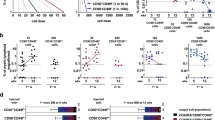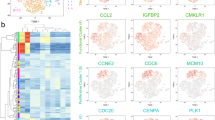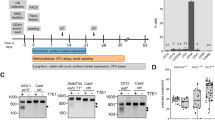Abstract
Very small embryonic-like stem cells (VSELs) are immature primitive cells residing in adult and fetal tissues. This study describes enrichment strategy and molecular and phenotypic characterization of human cord blood VSELs. Flow cytometry analysis revealed that a majority of VSELs (LIN−/CD45−/CD34+) were present in the red blood cell (RBC) pellet after Ficoll-Hypaque centrifugation in contrast to the hematopoietic stem cells (LIN−/CD45+/CD34+) in the interphase layer. Thus, after lyses of RBCs, VSELs were enriched using CD133 and SSEA4 antibodies. These enriched cells were small in size (4–6 μm), spherical, exhibited telomerase activity and expressed pluripotent stem cell (OCT4A, OCT4, SSEA4, NANOG, SOX2, REX1), primordial germ cell (STELLA, FRAGILIS) as well as primitive hematopoietic (CD133, CD34) markers at protein and transcript levels. Heterogeneity was noted among VSELs based on subtle differences in expression of various markers studied. DNA analysis and cell cycle studies revealed that a majority of enriched VSELs were diploid, non-apoptotic and in G0/G1 phase, reflecting their quiescent state. VSELs also survived 5-fluorouracil treatment in vitro and treated cells entered into cell cycle. This study provides further support for the existence of pluripotent, diploid and relatively quiescent VSELs in cord blood and suggests further exploration of the subpopulations among them.
This is a preview of subscription content, access via your institution
Access options
Subscribe to this journal
Receive 12 print issues and online access
$259.00 per year
only $21.58 per issue
Buy this article
- Purchase on Springer Link
- Instant access to full article PDF
Prices may be subject to local taxes which are calculated during checkout




Similar content being viewed by others
References
Virchow R . Archive fuerpathologische (Editorial). Anat Physiol Klin Med 1855; 8: 23–54.
Kucia M, Reca R, Campbell FR, Zuba-Surma E, Majka M, Ratajczak J et al. A population of very small embryonic-like (VSEL) CXCR4 (+) SSEA-1(+) Oct-4+ stem cells identified in adult bone marrow. Leukemia 2006; 20: 857–869.
Ratajczak MZ, Marycz K, Poniewierska-Baran A, Fiedorowicz K, Zbucka-Kretowska M, Moniuszko M . Very small embryonic-like stem cells as a novel developmental concept and the hierarchy of the stem cell compartment. Adv Med Sci 2014; 59: 273–280.
Kucia M, Wysoczynski M, Wu W, Zuba-Surma EK, Ratajczak J, Ratajczak MZ . Evidence that very small embryonic like (VSEL) stem cells are mobilized into peripheral blood. Stem Cells 2008; 26: 2083–2092.
Zuba-Surma EK, Kucia M, Dawn B, Guo Y, Ratajczak MZ, Bolli R . Bone marrow derived pluripotent very small embryonic-like stem cells (VSELs) are mobilized after acute myocardial infarction. J Mol Cell Cardiol 2008; 44: 865–873.
Paczkowska E, Kucia M, Koziarska D, Halasa M, Safranow K, Masiuk M et al. Clinical evidence that very small embryonic-like stem cells are mobilized into peripheral blood in patients after stroke. Stroke 2009; 40: 1237–1244.
Drukała J, Paczkowska E, Kucia M, Młyńska E, Krajewski A, Machaliński B et al. Stem cells, including a population of very small embryonic-like stem cells, are mobilized into peripheral blood in patients after skin burn injury. Stem Cell Rev 2012; 8: 184–194.
Kucia M, Halasa M, Wysoczynski M, Baskiewicz-Masiuk M, Moldenhawer S, Zuba-Surma E et al. Morphological and molecular characterization of novel population of CXCR4+ SSEA-4+ Oct-4+ very small embryonic-like cells purified from human cord blood: preliminary report. Leukemia 2007; 21: 297–303.
Shin DM, Zuba-Surma EK, Wu W, Ratajczak J, Wysoczynski M, Ratajczak MZ et al. Novel epigenetic mechanisms that control pluripotency and quiescence of adult bone marrow-derived Oct4 (+) very small embryonic-like stem cells. Leukemia 2009; 23: 2042–2051.
Ratajczak J, Wysoczynski M, Zuba-Surma E, Wan W, Kucia M, Yoder MC et al. Adult murine bone marrow-derived very small embryonic-like stem cells differentiate into the hematopoietic lineage after coculture over OP9 stromal cells. Exp Hematol 2011; 39: 225–237.
Ratajczak J, Zuba-Surma E, Klich I, Liu R, Wysoczynski M, Greco N et al. Hematopoietic differentiation of umbilical cord blood-derived very small embryonic/epiblast-like stem cells. Leukemia 2011; 25: 1278–1285.
Taichman RS, Wang Z, Shiozawa Y, Jung Y, Song J, Balduino A et al. Prospective identification and skeletal localization of cells capable of multilineage differentiation in vivo. Stem Cells Dev 2010; 19: 1557–1570.
Parte S, Bhartiya D, Telang J, Daithankar V, Salvi V, Zaveri K et al. Detection, characterization and spontaneous differentiation in vitro of very small embryonic-like putative stem cells in adult mammalian ovary. Stem Cells Dev 2011; 20: 1451–1464.
Kassmer SH, Bruscia EM, Zhang PX, Krause DS . Non-hematopoietic cells are the primary source of bone marrow-derived lung epithelial cells. Stem Cells 2012; 30: 491–499.
Kassmer SH, Jin H, Zhang PX, Bruscia EM, Heydari K, Lee JH et al. Very small embryonic-like stem cells from the murine bone marrow differentiate into epithelial cells of the lung. Stem Cells 2013; 31: 2759–2766.
Havens AM, Sun H, Shiozawa Y, Jung Y, Wang J, Mishra A et al. Human and murine very small embryonic-like cells represent multipotent tissue progenitors, in vitro and in vivo. Stem Cells Dev 2014; 23: 689–701.
Ratajczak MZ, Shin DM, Liu R, Marlicz W, Tarnowski M, Ratajczak J et al. Epiblast/germ line hypothesis of cancer development revisited: lesson from the presence of Oct-4+ cells in adult tissues. Stem Cell Rev 2010; 6: 307–316.
Bhartiya D, Singh J . FSH-FSHR3 - Stem cells in ovary surface epithelium: basis for adult ovarian biology, failure, aging and cancer. Reproduction 2015; 149: R35–R48.
Bhartiya D, Patel H . Very small embryonic-like stem cells are involved in pancreatic regeneration and their dysfunction with age may lead to diabetes and cancer. Stem Cells Res Ther, in press.
Zuba-Surma EK, Klich I, Greco N, Laughlin MJ, Ratajczak J, Ratajczak MZ . Optimization of isolation and further characterization of umbilical-cord-blood-derived very small embryonic/epiblast-like stem cells (VSELs). Eur J Haematol 2010; 84: 34–46.
Bhartiya D, Shaikh A, Nagvenkar P, Kasiviswanathan S, Pethe P, Pawani H et al. Very small embryonic-like stem cells with maximum regenerative potential get discarded during cord blood banking and bone marrow processing for autologous stem cell therapy. Stem Cells Dev 2012; 21: 1–6.
Danova-Alt R, Heider A, Egger D, Cross M, Alt R . Very small embryonic-like stem cells purified from umbilical cord blood lack stem cell characteristics. PLoS One 2012; 7: e34899.
Alvarez-Gonzalez C, Duggleby R, Vagaska B, Querol S, Gomez SG, Ferretti P et al. Cord blood Lin(-)CD45(-) embryonic-like stem cells are a heterogeneous population that lack self-renewal capacity. PLoS One 2013; 8: e67968.
Paczkowska E, Kawa M, Klos P, Staniszewska M, Sienko J, Dabkowska E . Aldehyde dehydrogenase (ALDH) - a promising new candidate for use in preclinical and clinical selection of pluripotent very small embryonic-like stem cells (VSEL SCs) of high long-term repopulating hematopoietic potential. Ann Transplant 2011; 16: 59–71.
Miyanishi M, Mori Y, Seita J, Chen JY, Karten S, Chan CKF et al. Do pluripotent stem cells exist in adult mice as very small embryonic stem cells? Stem Cell Reports 2013; 1: 198–208.
Szade K, Bukowska-Strakova K, Nowak WN, Szade A, Kachamakova-Trojanowska N, Zukowska M et al. Murine bone marrow Lin−Sca−1+CD45− very small embryonic-like (VSEL) cells are heterogeneous population lacking Oct-4A expression. PLoS One 2013; 8: e63329.
Thomson JA, Itskovitz-Eldor J, Shapiro SS, Waknitz MA, Swiergiel JJ, Marshall VS et al. Embryonic stem cell lines derived from human blastocysts. Science 1998; 282: 1145–1147.
Takahashi K, Tanabe K, Ohnuki M, Narita M, Ichisaka T, Tomoda K et al. Induction of pluripotent stem cells from adult human fibroblasts by defined factors. Cell 2007; 131: 861–872.
Anand S, Bhartiya D, Sriraman K, Patel H, Manjramkar DD . Very small embryonic-like stem cells survive and restore spermatogenesis after busulphan treatment in mouse testis. J Stem Cell Res Ther 2014; 4: 216.
Sriraman K, Bhartiya D, Anand S, Bhutda S . Mouse ovarian very small embryonic-like stem cells resist chemotherapy and retain ability to initiate oocyte-specific differentiation. Reprod Sci 2015; e-pub ahead of print 16 March 2015; doi:10.1177/1933719115576727.
Rice AM, Case J, Vowels MR . Cytokine-mediated expansion does not deplete cord blood cells with stem cell characteristics. Hematol Cell Ther 1997; 39: 125–131.
Rice A, Barbot C, Lacombe F, Dubosc-Marchenay N, Marit G, Hau F et al. 5-fluorouracil permits access to a primitive subpopulation of peripheral blood stem cells. Stem Cells 1993; 11: 326–335.
Shin DM, Liu R, Klich I, Wu W, Ratajczak J, Kucia M et al. Molecular signature of adult bone marrow-purified very small embryonic-like stem cells supports their developmental epiblast/germ line origin. Leukemia 2010; 24: 1450–1461.
Wang X, Dai J . Isoforms of OCT-4 contribute to the confusing diversity in stem cell biology. Stem Cells 2010; 28: 885–893.
Liedtke S, Enczmann J, Waclawczyk S, Wernet P, Kogler G . Oct4 and its pseudogenes confuse stem cell research. Cell Stem Cell 2007; 1: 364–366.
Lee J, Kim HK, Rho JY, Han YM, Kim J . The human OCT-4 isoforms differ in their ability to confer self-renewal. J Biol Chem 2006; 281: 33554–33565.
Zuba-Surma EK, Kucia M, Ratajczak J, Ratajczak MZ . "Small stem cells" in adult tissues: very small embryonic-like stem cells stand up!. Cytometry A 2009; 75: 4–13.
Ratajczak MZ, Mierzejewska K, Ratajczak J, Kucia M . CD133 expression strongly correlates with the phenotype of very small embryonic-/epiblast-like stem cells. Adv Exp Med Biol 2013; 777: 125–141.
Lévesque JP, Zannettino AC, Pudney M, Niutta S, Haylock DN, Snapp KR et al. PSGL-1- mediated adhesion of human hematopoietic progenitors to P-selectin results in suppression of hematopoiesis. Immunity 1999; 11: 369–378.
Ratajczak MZ . Phenotypic and functional characterization of hematopoietic stem cells. Curr Opin Hematol 2008; 15: 293–300.
Tachibana M, Amato P, Sparman M, Gutierrez NM, Tippner-Hedges R, Ma H et al. Human embryonic stem cells derived by somatic cell nuclear transfer. Cell 2013; 153: 1228–1238.
Tabar V, Studer L . Pluripotent stem cells in regenerative medicine: challenges and recent progress. Nat Rev Genet 2014; 15: 82–92.
Mierzejewska K, Borkowska S, Suszynska E, Suszynska M, Poniewierska-Baran A, Maj M et al. Hematopoietic stem/progenitor cells express several functional sex hormone receptors-novel evidence for a potential developmental link between hematopoiesis and primordial germ cells. Stem Cells Dev 2015; 24: 927–937.
Chen ZH, Lv X, Dai H, Liu C, Lou D, Chen R et al. Hepatic regenerative potential of mouse bone marrow very small embryonic-like stem cells. J Cell Physiol 2014; e-pub ahead of print 24 December 2014; doi:10.1002/jcp.24913.
Bhartiya D, Mundekar A, Mahale V, Patel H . Very small embryonic-like stem cells are involved in regeneration of mouse pancreas post-pancreatectomy. Stem Cell Res Ther 2014; 5: 106.
Lee SJ, Park SH, Kim YI, Hwang S, Kwon PM, Han IS et al. Adult stem cells from the hyaluronic acid-rich node and duct system differentiate into neuronal cells and repair brain injury. Stem Cells Dev 2014; 23: 2831–2840.
Guerin CL, Loyer X, Vilar J, Cras A, Mirault T et al. Bone-marrow-derived very small embryonic-like stem cells in patients with critical leg ischaemia: evidence of vasculogenic potential. Thromb Haemost 2015; e-pub ahead of print 22 January 2015; doi:10.1160/TH14-09-0748.
Takahashi M, Matsuoka Y, Sumide K, Nakatsuka R, Fujioka T, Kohno H et al. CD133 is a positive marker for a distinct class of primitive human cord blood-derived CD34-negative hematopoietic stem cells. Leukemia 2014; 28: 1308–1315.
Weissman IL, Shizuru JA . The origins of the identification and isolation of hematopoietic stem cells, and their capability to induce donor-specific transplantation tolerance and treat autoimmune diseases. Blood 2008; 112: 3543–3553.
Shin DM, Liu R, Wu W, Waigel SJ, Zacharias W, Ratajczak MZ et al. Global gene expression analysis of very small embryonic-like stem cells reveals that the Ezh2-dependent bivalent domain mechanism contributes to their pluripotent state. Stem Cells Dev 2012; 21: 1639–1652.
Kassmer SH, Krause DS . Very small embryonic-like cells: biology and function of these potential endogenous pluripotent stem cells in adult tissues. Mol Reprod Dev 2013; 8: 677–690.
Ratajczak MZ, Zuba-Surma E, Wojakowski W, Suszynska M, Mierzejewska K, Liu R et al. Very small embryonic-like stem cells (VSELs) represent a real challenge in stem cell biology: recent pros and cons in the midst of a lively debate. Leukemia 2014; 28: 473–484.
Fuchs E, Segre JA . Stem cells: a new lease on life. Cell 2000; 100: 143–155.
Gronthos S, Zannettino AC, Hay SJ, Shi S, Graves SE, Kortesidis A et al. Molecular and cellular characterization of highly purified stromal stem cells derived from human bone marrow. J Cell Sci 2003; 116: 1827–1835.
Kim NW, Piatyszek MA, Prowse KR, Harley CB, West MD, Ho PL et al. Specific association of human telomerase activity with immortal cells and cancer. Science 1994; 266: 2011–2015.
Chiu CP, Dragowska W, Kim NW, Vaziri H, Yui J, Thomas TE et al. Differential expression of telomerase activity in hematopoietic progenitors from adult human bone marrow. Stem Cells 1996; 14: 239–248.
Acknowledgements
We thank Dr Mukherjee, Gayatri Shinde, Sushma Khavale, Nivedita Dhavale, Dr Babu Rao, Dr Tamhankar, Harshvardhan Gawade and Dr Khatkhatay for their help. We also thank University Grants Commission, New Delhi, for support toward doctoral program of Ambreen Shaikh. Financial support for the study was provided by Indian Council of Medical Research, Government of India, New Delhi (Accession no. RA/214/01-2015).
Author information
Authors and Affiliations
Corresponding author
Ethics declarations
Competing interests
The authors declare no conflict of interest.
Additional information
Supplementary Information accompanies this paper on the Leukemia website
Supplementary information
Rights and permissions
About this article
Cite this article
Shaikh, A., Nagvenkar, P., Pethe, P. et al. Molecular and phenotypic characterization of CD133 and SSEA4 enriched very small embryonic-like stem cells in human cord blood. Leukemia 29, 1909–1917 (2015). https://doi.org/10.1038/leu.2015.100
Received:
Revised:
Accepted:
Published:
Issue Date:
DOI: https://doi.org/10.1038/leu.2015.100
This article is cited by
-
Initiation of Cancer: The Journey From Mutations in Somatic Cells to Epigenetic Changes in Tissue-resident VSELs
Stem Cell Reviews and Reports (2024)
-
Proteomic Analysis of Murine Bone Marrow Very Small Embryonic-like Stem Cells at Steady-State Conditions and after In Vivo Stimulation by Nicotinamide and Follicle-Stimulating Factor Reflects their Germ-Lineage Origin and Multi Germ Layer Differentiation Potential
Stem Cell Reviews and Reports (2023)
-
In Vitro Simulated Neuronal Environmental Conditions Qualify Umbilical Cord Derived Highly Potent Stem Cells for Neuronal Differentiation
Stem Cell Reviews and Reports (2023)
-
Additional evidence to support OCT-4 positive VSELs and EnSCs as the elusive tissue-resident stem/progenitor cells in adult mice uterus
Stem Cell Research & Therapy (2022)
-
Mice Uterine Stem Cells are Affected by Neonatal Endocrine Disruption & Initiate Uteropathies in Adult Life Independent of Circulatory Ovarian Hormones
Stem Cell Reviews and Reports (2022)



